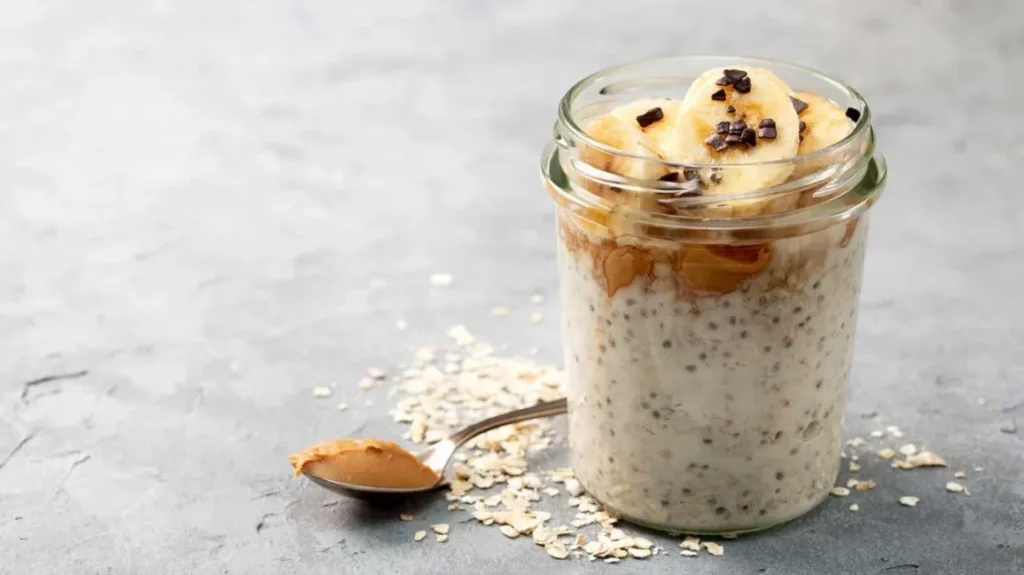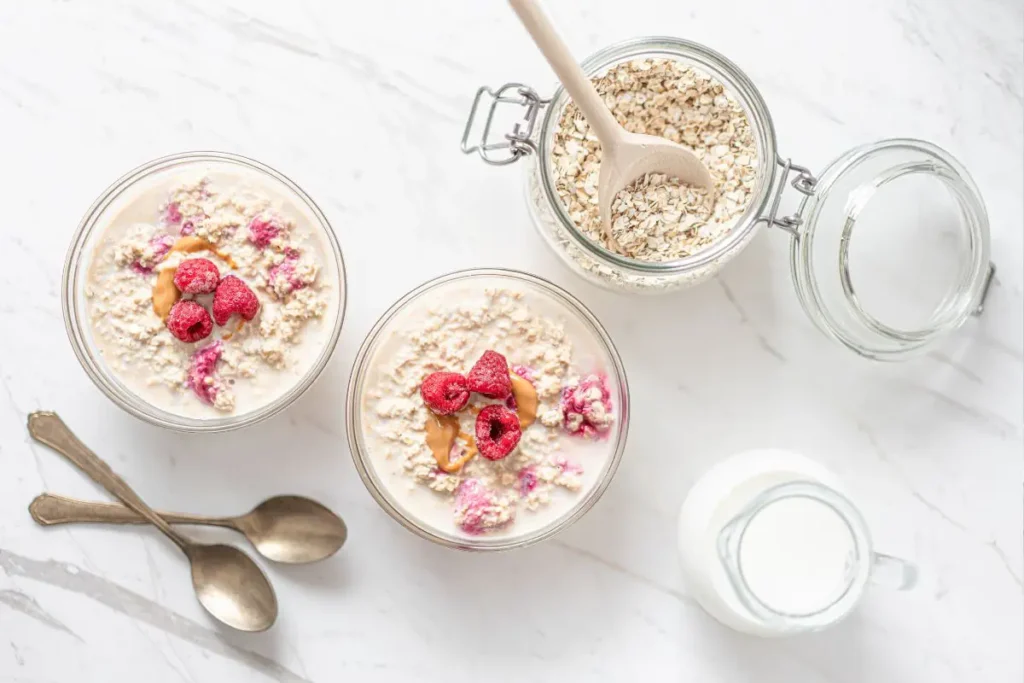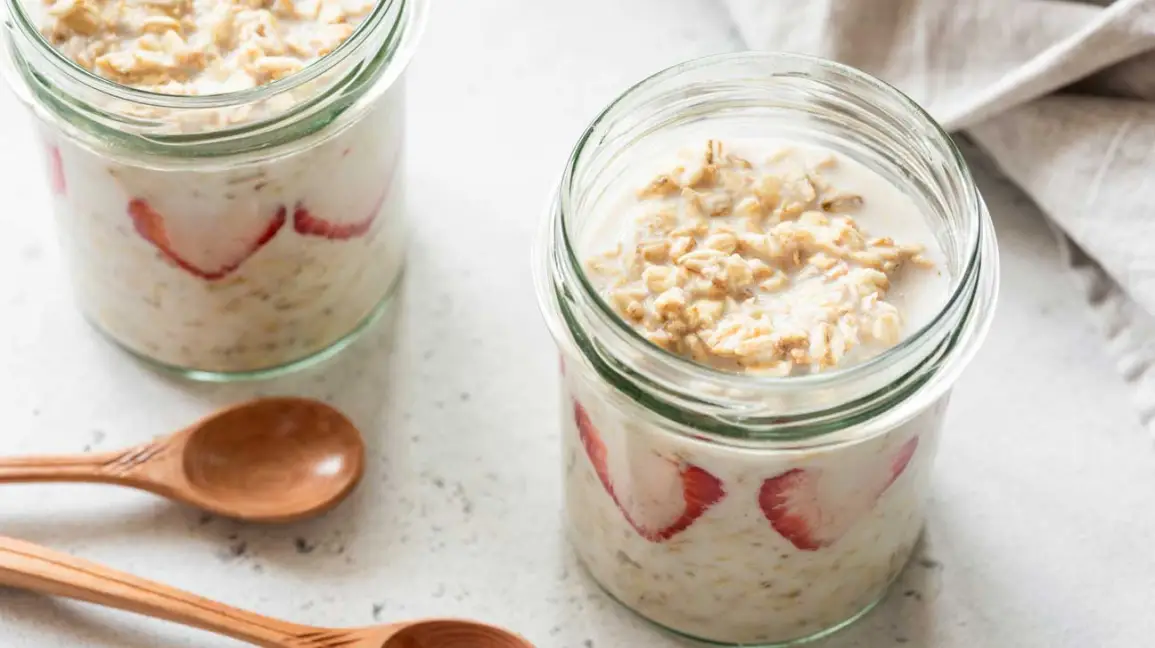In the realm of quick and nutritious breakfast options, they have emerged as a frontrunner. But what if we told you there’s a way to skip the stove and still enjoy this wholesome grain? The question arises: Can you eat oats soaked in milk without cooking them?
Yes, you can eat oats soaked in milk without cooking them. Soaking oats in milk overnight softens them, making for a convenient and nutritious meal. This method enhances digestibility and nutrient absorption, providing a time-saving and customizable option for a wholesome breakfast.
Keep Reading For More Interesting Facts
Nutrition Facts for Oats with Soaked Milk
| Nutrient | Per 100g | Per 40g Serving | % Daily Value (40g) |
| Calories | 1663.1 kJ / 397.5 kcal | 665.3 kJ / 159 kcal | 8% |
| Total Fat | 6.3g | 2.5g | 4% |
| Saturated Fat | 2g | 0.8g | 4% |
| Total Carbohydrates | 75g | 30g | 12% |
| Dietary Fiber | 5.5g | 2.2g | |
| Protein | 11g | 4.4g | 9% |
| Sodium | 0.6g | 0.2g | 4% |
Simple Overnight Oats: No-Cook, All Flavor

Making overnight oats is a breeze since oats have little flavor. You can mix things up, going from sweet to savory to keep it interesting. All you have to do is let your raw oats soak in milk overnight or for a few hours. Here are some types of milk you can use:
- Coconut milk
- Almond milk
- Soy milk
- Any other non-dairy milk
After that, you can add seeds for extra nutrition and a different feel. Try adding these seeds to your oats:
- Flax seed
- Chia seeds
- Pumpkin seeds
- Sunflower seeds
Furthermore, chia seeds are especially cool because they make your oats thick and creamy. Plus, they’ve got omega-3s, protein, fiber, and minerals. If you’re into keeping your blood sugar steady, chia seeds are a good call, especially with some added fruit.
Now, toss in some fresh or frozen fruit. Berries or bananas, you really can’t go wrong. For a protein boost, add nuts like walnuts or almonds to make a parfait.
If you’re avoiding regular sweeteners, try toppings like agave or maple syrup. And for the finishing touch, a sprinkle of cinnamon.
Quick Recipe
- Just mix raw oats with milk and let them sit for at least two hours. Easy peasy!
- For the best results, let oats soak in milk overnight. Wake up to ready-to-eat oatmeal without the stove hassle.
- Soaking makes them pleasantly soft. For a thick texture, go for 12 to 24 hours.
- Any milk works – dairy or non-dairy like coconut, almond, or soy.
- No morning cooking is needed. Prep in advance for a stress-free breakfast.
- Soaked ones can be creamier than cooked ones. Enjoy the texture upgrade!
- They absorb goodness from the milk, adding a nutritional punch.
- Enjoy cold oats from the fridge or warm them up for a cozy breakfast.
Harnessing the Health Prowess of Oats: A Comprehensive Overview
Embarking on a journey of wellness, oats emerge as a nutritional powerhouse, offering an array of health benefits backed by scientific evidence:
- Cholesterol Management:
- Abundant in beta-glucan, oats prove effective in reducing cholesterol levels. Research suggests a daily intake of at least 3 grams of oat beta-glucan can lead to a 5–10% decrease in blood cholesterol.
- Blood Sugar Control:
- Beta-glucan’s gel-forming ability aids in blood sugar control, particularly crucial for those with type 2 diabetes. Studies show a 46% reduction in blood sugar levels with daily consumption of foods rich in beta-glucan.
- Heart Health Promotion:
- Soluble fibers in oats, such as beta-glucans, contribute to lowering blood pressure. Evidence indicates that a daily intake of 8 grams of soluble fiber from oats significantly reduces both systolic and diastolic blood pressure.
- Gut Health Support:
- They play a role in maintaining a healthy bowel by increasing fecal bulk through insoluble fiber. Regular oat fiber intake proves effective in treating constipation, with 59% of participants able to discontinue laxatives.
- Weight Management:
- Whole-grain cereals like them are linked to a lower risk of weight gain and obesity. The soluble fibers, particularly beta-glucans, contribute to increased feelings of fullness, aiding in weight maintenance or loss.
Navigating Oat Varieties: Quick, Instant, and Old-fashioned Explained
| Characteristic | Quick Oats | Instant Oats | Old-fashioned Oats |
| Processing Level | Partially cooked, ready for blending | Highly processed, suitable for raw consumption | Steamed, level of safety depends on the steaming process |
| Added Sugar | Check the label for potential added sugar | May vary, but typically more processed | Natural, maybe a safe option depending on steaming |
| Safety Consideration | Steaming duration crucial for safety and digestion | Generally safe for raw consumption | Steaming process determines safety for raw eating |
| Texture | Blender-ready, versatile for various uses | Produces a fine texture, great for smoothies | Hearty texture, suited for traditional oatmeal |
| Nutritional Profile | Offers a nutritional punch | Lowest nutritional content among the three | Robust nutritional profile, especially when cooked |
Choosing the Right Oats for Your Smoothie
Not all oats play nice in your smoothie. Here’s a quick guide on oats to skip for a creamier and safer blend:
- Steel-Cut Oats:
- While these oats add texture, their coarse nature may not blend as smoothly as quick or rolled oats.
- Whole Oat Groats:
- Tough and unprocessed, these groats may not be the best fit for your smoothie adventure. They include bran, cereal germ, and endosperm, making them less ideal for blending.
- Oat Bran:
- Although oat bran is digestible and has its benefits, it may promote bacteria growth. However, if you fancy a grittier texture, oat bran could be an option.
Savoring Soaked Milk Oats: Creative Ways to Elevate Your Breakfast Routine

- Classic Overnight Oats:
- Combine oats with your choice of milk (coconut, almond, soy, etc.) in a jar or bowl.
- Let them soak overnight in the refrigerator.
- In the morning, stir well and add your favorite toppings like fresh fruits, nuts, or seeds.
- Fruit and Yogurt Parfait:
- Layer soaked oats with yogurt and a variety of fresh or frozen fruits in a glass.
- Repeat the layers and top with a drizzle of honey or maple syrup for added sweetness.
- Smoothie Bowl Base:
- Blend them with your favorite fruits and a splash of milk to create a creamy smoothie.
- Pour the smoothie into a bowl and add toppings like granola, sliced bananas, or chia seeds.
- Oatmeal Breakfast Cookies:
- Mix them with mashed bananas, a bit of honey, and your favorite nuts or chocolate chips.
- Form into cookies and bake for a quick and healthy breakfast option.
- Protein-Packed Oat Pancakes:
- Blend soaked oats with eggs, a banana, and a dash of baking powder to make a pancake batter.
- Cook small pancakes on a griddle and serve with yogurt and berries.
- Energy-Boosting Oat Smoothie:
- Blend them with milk, a scoop of protein powder, a handful of spinach, and a tablespoon of nut butter for a nutrient-packed smoothie.
- Savory Oat Bowl:
- Instead of sweet toppings, try savory options like sautéed vegetables, a fried egg, and a sprinkle of cheese for a savory oat bowl.
- Oatmeal Muffins:
- Mix them with flour, baking powder, and your favorite add-ins like blueberries or shredded coconut.
- Spoon the batter into muffin cups and bake for a convenient, grab-and-go breakfast.
FAQ’s
Can you eat oats soaked in milk?
Yes, you can eat oats soaked in milk. Soaking raw oats in milk softens them, making them palatable without the need for cooking.
Is it better to eat oats raw or cooked?
Cooking oats increases their nutritional value. Harvard Health recommends cooking or making overnight oats for a tastier and nutritious option.
How long should I soak raw oats before eating?
Soak raw oats for 6 hours or overnight to improve digestibility and yield fluffier, creamier oats.
Can we use raw milk for oats?
Yes, raw milk can be used for overnight oats, offering a rich and creamy finish to the preparation.
Is it necessary to boil oats in milk?
No, Boiling oats in milk can result in a creamy consistency. Using enough water is key to achieving a not-gluey bowl of oatmeal.
Can I eat oats with cold milk?
Yes, instant rolled oats are edible with cold milk. They are pre-cooked and dried, allowing them to soften when combined with cold milk.
Should I eat oats with milk or water?
Eating oats with milk is preferable as it adds fats, calcium, and Vitamin D, complementing the nutrients in oats and contributing to overall health.
Final Words
In conclusion, opting to eat oats soaked in milk without cooking them is not only permissible but also offers a convenient and nutritious alternative to traditional cooked oats.
Furthermore, the soaking process not only enhances digestibility but also allows for the absorption of essential nutrients. This versatile and time-saving method opens the door to a variety of flavor combinations, making it a healthy and enjoyable addition to your breakfast routine.

